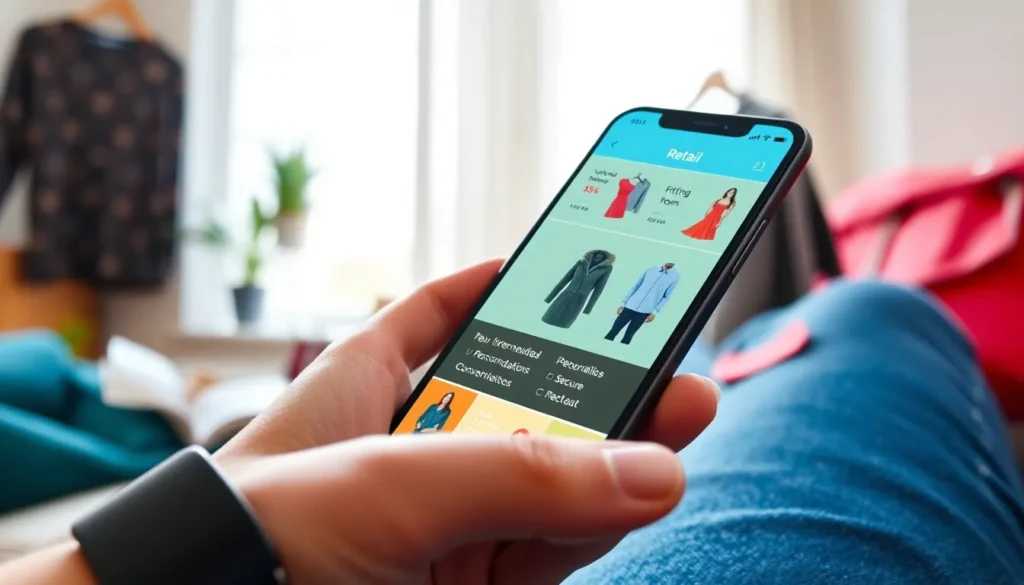Have you ever been shopping and thought, ‘If only I could do this in my pajamas’? Well, retail mobile apps have turned that dream into reality. They’ve transformed the mundane chore of shopping into a seamless adventure right at your fingertips. With everything from virtual fitting rooms to personalized recommendations, these apps make shopping more enjoyable, engaging, and, dare we say it, fun. Sit tight as we explore the innovations in retail mobile apps that are redefining how consumers interact with their favorite stores.
Table of Contents
ToggleThe Rise of Mobile Shopping

The world has gone mobile, and shopping is no exception. Over the last few years, mobile shopping has skyrocketed, transforming the retail landscape. According to recent statistics, mobile commerce is projected to account for 72.9% of total e-commerce sales by 2021. It’s hard to ignore the convenience this brings.
As smartphones become increasingly ubiquitous, shoppers are using them to browse, shop, and purchase products from anywhere, at any time. Moving from brick-and-mortar stores to mobile devices has changed consumer behaviors significantly. Many prefer to shop through apps rather than websites, thanks to the speed and ease of use. This shift has motivated businesses to invest heavily in their mobile apps, prompting developers to innovate and improve user experiences further.
Key Features of Retail Mobile Apps
Every successful retail mobile app comes with a suite of essential features designed to enhance user experience.
User-Friendly Interface
A clean, intuitive interface makes it easy for users to navigate through various offers and products. The first impression matters: if an app is too complicated, users will likely abandon it in favor of something simpler.
Push Notifications
These real-time alerts keep customers informed about exclusive deals, upcoming sales, and new arrivals, ensuring they never miss out on savings.
Secure Payment Options
Integrating multiple secure payment methods, like credit cards, PayPal, and even crypto, creates a sense of security. With growing concerns over online security, offering diverse options can enhance trust.
Personalization
Leveraging AI for personalized recommendations not only tailors the shopping experience but also significantly boosts conversion rates. You’ve probably noticed how your favorite apps suggest items based on your past purchases.
Wishlist Functionality
This feature allows users to save items for later, encouraging them to return for a second look. After all, who hasn’t left an item in their cart just because they weren’t ready to buy yet?
Benefits of Using Retail Mobile Apps
Retail mobile apps are not just a marketing gimmick: they provide substantial benefits for both companies and consumers.
Convenience
At the top of the list is convenience. Users can shop whenever and wherever they want, without the constraints of store hours.
Enhanced Customer Engagement
Apps can foster stronger customer relationships through loyalty programs, personalized offers, and timely notifications, ensuring customers feel valued and connected.
Increased Sales
Studies show that consumers spend more when shopping via mobile apps compared to their desktop counterparts. This means businesses that embrace mobile shopping often see a considerable boost in revenue.
Streamlined Operations
Retail mobile apps simplify transactions and manage inventory more effectively, making everything from ordering supplies to tracking sales easier for businesses.
Best Practices for Designing Retail Mobile Apps
Creating a compelling retail mobile app requires strategic thinking and attention to detail. Here are some best practices:
Prioritize Speed and Performance
Apps that lag or crash frustrate users faster than you can say “load time.” Optimizing apps for speed leads to better retention rates.
Invest in User Experience (UX)
Ensuring a seamless and engaging UX design can be a game changer. Think simple navigation, sensible layouts, and appealing visuals.
Incorporate Feedback Loops
Encouraging user feedback helps developers make necessary improvements and showcases that the brand values its customers’ opinions.
Keep Up with Trends
Staying current with design trends, technology advancements, and consumer preferences guarantees your app remains relevant in a rapidly evolving marketplace.
Challenges Facing Retail Mobile Apps
Even though the many advantages, the journey to a successful retail mobile app is paved with challenges.
Data Privacy Concerns
In an age where consumers are increasingly aware of data privacy issues, ensuring robust security measures is paramount. Many users hesitate to engage in mobile transactions out of fear over data misuse.
Market Saturation
The app stores are crowded with retail apps, making it hard for new or smaller brands to stand out. Effective marketing strategies and unique offerings are essential to cut through the clutter.
Technical Issues
Bugs, crashes, and user complaints can hamper the app’s reputation. Continuous updates and testing are necessary to maintain functionality and enhance user satisfaction.
Future Trends in Retail Mobile Apps
The future looks bright for retail mobile apps, with several trends poised to make significant impacts.
Augmented Reality (AR)
Imagine trying on clothes or seeing how a piece of furniture would look in your living room without leaving home. AR is set to transform consumer experiences like never before.
Artificial Intelligence (AI)
AI will continue to enhance personalization by analyzing user behaviors and preferences, creating a uniquely tailored shopping experience for each individual.
Voice-Activated Shopping
As virtual assistants become more mainstream, voice-activated shopping will likely gain traction. Picture simply speaking your order while cooking dinner. This could revolutionize how users interact with retail apps.





